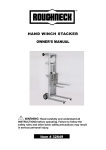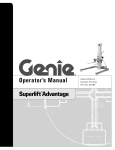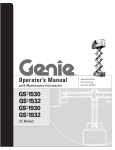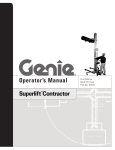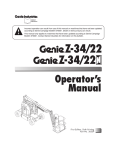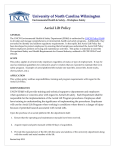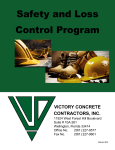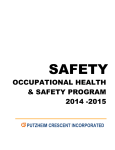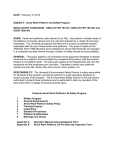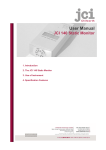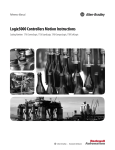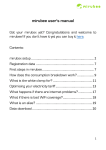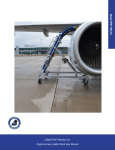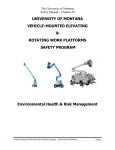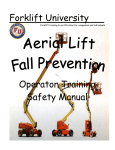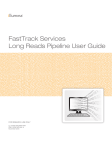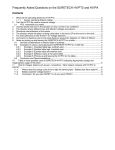Download Aerial Lifts - UCI Environmental Health & Safety
Transcript
UC Irvine Environmental Health & Safety SECTION: TITLE: Aerial Work Platforms INITIATOR: David Mori REVISION DATE 12/09/14 1. Program Description 2. Scope 3. Definitions 4. Responsibilities 5. Program Components 6. Reporting requirements 7. Training Requirements and Competency Assessment 8. Information and External References 9. Appendices A. Operator’s Manual Acknowledgement Form B. Aerial Work Platform Pre-Operation Inspection Form C. Minimum Safe Approach Distance Chart Page 1 of 12 1. Program Description Aerial work platforms (AWP’s) such as scissor lifts, vertical lifts, boom lifts, and aerial bucket trucks, are used throughout the UC Irvine campus operated by campus staff and contractors. The University recognizes that there are a number of potential hazards associated with the use of these aerial work platforms. This program is based on the American National Standards Institute (ANSI) and the Scaffold Industry Association (SIA) Standards and is designed to ensure that aerial work platforms are operated in a safe and consistent manner through a system of safety checks and accountability. 2. Scope This program applies to all University-owned or rented equipment designed to elevate personnel on a platform that is propelled by a powered lifting device, with the controls located on the platform itself. It applies to departments that own the equipment and the employees who use them. Examples of aerial work platforms include vertical lifts, scissor lifts, boom lifts, and aerial bucket trucks. 3. Definitions Aerial Work Platform (AWP) – A mobile device that has an adjustable position platform supported from ground level by a structure. Anchorage – A secure point of attachment for fall protection equipment. ANSI/SIA – American National Standards Institute/Scaffold Industry Association. Boom – A straight or articulated beam that supports the work platform. Boom Lift – A mobile, self propelled boom supported work platform that can be raised or lowered vertically or extended and retracted horizontally and pivoted around a supporting base. Cal/OSHA – California Occupational Safety and Health Administration. Lower Controls - Controls located on the base of the aerial work platform that can control the functions of the lift platform. Operator – The trained and authorized person who controls the movement of an aerial platform. This could include any employee or subcontractor using an aerial work platform owned, rented, or leased by UC Irvine. Outriggers – Devices that increase the stability of the aerial work platform and are capable of lifting and leveling the aerial work platform base. Owner - Persons or entities that have possession of an aerial work platform. UC Irvine Departments, such as Facilities Management, Student Services, School of the Arts, and others, that own, lease, or rent the equipment are considered owners. Owners are responsible for conducting maintenance inspections and ensuring operators are trained and authorized to use the equipment. Platform – The part of the aerial lift platform that is designed for occupancy by personnel with their necessary tools and materials. Rated Load Capacity - The safe maximum carrying capacity of the work platform. This would include the evenly distributed weight of the occupants plus all tools or materials on the platform. Scissor Lift – Mobile, self-propelled work platform that can only be raised or lowered vertically from the base. Page 2 of 12 Stabilizers – Devices that increase the stability of an aerial lift platform but are not capable of lifting or leveling the aerial platform. Upper controls - Controls located on the platform or bucket of the AWP that the operator uses to control the movement of the lift. User - Persons or entities that have care, control and custody of the AWP. This person or entity may also be the employer of the operator, an owner, or lessee. At UC Irvine, departments such as Facilities Management are considered users. Vertical Lift – A personnel lift consisting of a work platform normally for one occupant attached to a vertically extending mast mounted on a mobile base. Equipment models can be self-propelled or manually propelled. 4. Responsibilities Department A. Responsibilities Upon Purchase Upon the purchase of an aerial work platform (AWP), the department shall: • Ensure that the operating and maintenance manuals have been received. • Acquire repair and parts manuals within 60 days of acquisition. • Provide the manufacturer of the lift with the name and address of the University department along with the model and serial number of the AWP. • Have all lift operators review the operating manual, complete and sign the “Operator’s Manual Acknowledgment Form” (Appendix A) and return it to their supervisor for documentation. • Perform an Initial Inspection (Frequent Inspection) as specified in Section 5.B.2 of this program prior to placing the AWP in service. • Ensure copies of the operating and maintenance manuals are placed in the weatherproof compartment on the lift. B. Maintenance, Inspection and Repair • • • Maintenance: The department responsible for each aerial work platform shall arrange for maintenance that is appropriate for their lift. The department shall establish a preventive maintenance program based on the manufacturer’s recommendations, the environment in which it is to be used, and the frequency at which it is to be used. Inspection: The department shall ensure that Pre-operation inspections, frequent inspections, and annual inspections are being performed on the lift as specified in Section 5.B.1 of this program. Repair: When safety related items have been discovered, the lift shall be placed out of service until the item(s) has been repaired. All replacement parts or components that are replaced shall be identical to or equivalent to the original parts based on information provided by the manufacturer or supplier. C. Records Retention Page 3 of 12 Each department shall date and retain the following records for each aerial work platform they own: • Serial number and date of purchase (this shall be kept for as long as the department owns the lift. • Written records of the frequent and annual inspections and repairs performed. This shall include deficiencies found, corrective actions taken and the identification of the person(s) who performed the inspection and repairs. • Written records of repairs made on the lift. • Training records for any employees trained in the maintenance of the aerial work platform. Each department shall date and retain the records for each aerial work platform for at least the time prescribed in the following table: Pre-Operation Inspection Forms Frequent or Initial Inspections, Annual Inspections, and Repairs Lift Operator Training Records Scissor Lifts Bucket Trucks Boom or Manlift Three Years Three Years Three Years Duration of Ownership Duration of Ownership Duration of Ownership Four Years Four Years Four Years Employees Because the user has direct control over the operation of the aerial lift, conformance with good safety practices in this area is the responsibility of the user and operating personnel. Decisions on the use and operation of the lift shall be made with the understanding that the platform will be carrying personnel whose safety is dependent on those decisions. Employees who operate aerial lifts shall be knowledgeable of the following: • The manufacturer's operating instructions • Pre-operation inspection of the lift • Function testing, setup, and operation of the lift • Inspection of the work area for dangerous conditions such as uneven surfaces, overhead obstructions such as power lines, or other hazards. • Setting up of barricades or warning lines to protect pedestrians, students, and others from overhead work hazards • Load capacities of the equipment • How to safely move the equipment • Prevention of falls and the use appropriate fall protection and other appropriate personal protective equipment • Minimum safe approach distances to energized power lines Page 4 of 12 A. Manuals Operators of aerial work platforms must acknowledge that they have reviewed the operator’s manual for the lifts that they use. Documentation of this shall be established by having the employee complete and sign the form titled “Operator’s Manual Acknowledgement Form” (Appendix A). The operator is expected to know and understand the following information about the AWP they operate prior to initial operation of the lift: • • • • • • The operation of the lift All control features of the lift All placard warnings All safety devices on the lift Where to locate the user manual Who can operate or use the platform lift If the operator does not understand any of the above they shall consult with their supervisor prior to using the AWP. B. Inspection and Maintenance Users shall inspect and maintain the aerial work platform as required by their department to ensure proper operation. Note: Some employees may be approved by their department to operate but not to perform maintenance on the AWP. All operators shall perform pre-operation inspections prior to each use of the lift. Pre-operation inspections shall be documented by completing an “Aerial Work Platform Pre-Operation Inspection Form” (Appendix C). Aerial work platforms that are not in proper operating condition shall be immediately removed from service and reported to the appropriate departmental supervisor. Only employees who are authorized by their department may perform maintenance duties on the lifts. C. Workplace Inspections Prior to setting up the lift at each new location the operator shall conduct a workplace inspection as specified in Section 5.B.4 to identify potential hazards. Appropriate barricades or warning lines will be placed to protect all pedestrians or other unauthorized individuals from potential overhead hazards. D. Training Only trained and authorized employees may operate aerial work platforms. For maintenance, only employees who have been trained on maintenance operations for specific lifts may perform these duties. Page 5 of 12 Environmental Health & Safety (EH&S) • Shall develop an aerial work platform program and revise it when necessary. • Shall provide for the training of operators and users of aerial work platforms upon request by departments and ensure training records are maintained. • Shall provide technical support to departments and employees when questions or concerns arise with regards to aerial work platform safety. • Shall perform periodic review and audits of aerial lift operations to ensure that University procedures are enforced and safe work practices are used. 5. Program Components A. General Guidelines To ensure safe practices, the following general procedures are followed when a trained operator uses an aerial work platform: • Obtain any necessary authorization to use the lift. • Check the last Pre-operation inspection for any comments or notes. • Perform a Pre-operation inspection on the lift, document the inspection and place it in the reserved storage location on the lift. • Perform a workplace inspection in the area that the lift will be used. • Mark or barricade the work area to ensure no unauthorized persons enter the work area. • Extend and adjust the outriggers, stabilizers, extendible axles, or other stability enhancing means. • Ensure that the guardrails are installed and are in place. • Ensure that the load being placed on the lift is within the rated capacity of the lift. • Test the upper and lower controls of the lift. • Ensure that all personnel on the lift are using all appropriate fall protection equipment and have been trained and authorized to operate or work on the platform. No aerial lift will be “field modified” for uses other than those intended by the manufacturer unless: • The manufacturer certifies the modification in writing, or • Any other equivalent entity, such as a nationally recognized testing lab, certifies the aerial lift modification conforms to all applicable provisions of ANSI A92.2-2009. The lift must be at least as safe as the equipment was before modification. B. Inspections The inspection process is a critical step in preventing aerial lift incidents that are caused from faulty or worn out equipment. Aerial work platforms that are not in proper operating condition shall be immediately removed from service until the problems have been corrected by an authorized and trained maintenance technician. Page 6 of 12 1. Pre-Operation Inspection Before each use of the aerial work platform, a Pre-operation Inspection and Function Test must be performed by the operator. The inspection must be completed in accordance with the aerial work platform manufacturer operator’s manual and should include at least the following: • Copies of Operator’s Manual and ANSI/SIA Manual of Responsibilities are stored on the lift • Annual Inspection has been performed within the last 13 months • Operating and emergency controls • Safety devices • Personal protective devices • Air, hydraulic and fuel system leaks • Cables and wiring harness • Loose or missing parts • Tires and wheels • Placards, warnings, and control markings • Outriggers, stabilizers and other structures • Guardrail system • Other items specified by manufacturer 2. Frequent Inspection (Initial Inspection) Any time an aerial work platform has not been used for a period of 3 months or more, or when the lift is first acquired, a frequent inspection shall be performed by a qualified person and shall include the following: • All functions and their controls for speed(s) smoothness, and limits of motion. • Lower controls including the provisions for overriding of upper controls. • All chain and cable mechanisms for adjustment wear or damaged parts. • All emergency and safety devices. • Lubrication of all moving parts, inspection of filter element(s), hydraulic oil, engine oil, and coolant as specified by the manufacturer. • Visual inspection of structural components and other critical components such as fasteners, pins, shafts and locking devices. • Placard, warnings and control markings. • Additional items specified by the manufacturer. 3. Annual Inspection An annual inspection shall be performed on each aerial platform at least every 13 months. The inspection shall be performed by a qualified mechanic who is authorized to perform maintenance duties on the lift. The inspection shall include all items specified by the manufacturer for an annual inspection. 4. Workplace Inspection Before an aerial work platform is used and during its use, the operator shall inspect the work area in accordance with the lift manufacturer operator’s manual for possible hazards including, but not limited to: Page 7 of 12 • • • • • • • • • • Drop-offs or holes Slopes Bumps and floor obstructions Debris Overhead obstructions and energized power lines Hazardous locations and atmospheres Inadequate surface and support to withstand all load forces imposed by the aerial work platform Wind and weather conditions Protection of pedestrians and any other unauthorized people Other possible unsafe conditions C. Fall Protection The use of fall protection is required by all occupants of aerial work platforms at UC Irvine. When operating boom lifts or aerial bucket trucks the use of personal fall protection equipment, consisting of a full body harness and shock absorbing lanyard, is required. For scissor lifts or other vertical lift equipment the use of a body-belt with a non-shock absorbing lanyard is acceptable. D. Working Around Power Lines Aerial lifts are not normally insulated for use near electrically energized circuits such as power lines or exposed bus bars. In general, scissor lifts are not electrically insulated and will not provide protection from contact with or proximity to electrical current. Any aerial lift intended for use around electrically energized circuits shall meet the electrical requirements of American National Safety Institute/Scaffold Industry Association (ANSI/SIA) A92.2-2001, “Vehicle-Mounted Elevating and Rotating Aerial Devices.” Refer to the manufacturer operator’s manual and identification plate affixed to the machine for the category of insulating aerial device, if applicable. Operators shall maintain safe distances from electrical power lines and apparatus in accordance with governmental regulations and the Minimum Safe Approach Distance (MSAD) chart (Appendix C). 6. Reporting Requirements Constant awareness of and respect for aerial lift platforms and equipment and compliance with all applicable UC Irvine safety rules is mandatory. Supervisors may issue warnings and implement disciplinary actions for failure to follow the guidelines of this program. Employees shall report any safety concerns to their supervisor or EH&S. 7. Training Requirements and Competency Assessment Page 8 of 12 All persons operating aerial lift platforms must have initial training prior to using the equipment and periodically thereafter. Initial training may be provided by EH&S or Department authorized trainers and will include classroom instruction and familiarization on specific operating characteristics of aerial lift equipment. The contents of the training will include the following: • Purpose and use of operator’s manuals • Requirements for annual and periodic inspections • Pre-operation inspections • Function tests • Identification of malfunctions and problems • Factors affecting stability • Purpose of placards and decals • Workplace inspections • Safety rules and regulations • Authorization to operate • Operator warnings and instructions • Operation of the aerial platform • Operator evaluation The operator shall be retrained as soon as possible if unsafe behavior is observed. Refresher training is required every three years for scissor lifts, vertical lifts, boom lifts, and aerial bucket trucks. 8. Information and External References Title 8 California Code of Regulations, General Industry Safety Orders - §3299, §3636, §3637, §3638, §3639, §3640, §3642, §3643, §3645, §3646, §3648 29 CFR 1910, Subpart F, “Powered Platforms, Manlifts, and Vehicle-Mounted Work Platforms,” 1910.66, 1910.67, 1910.68 29 CFR 1926, Subpart L, “Scaffolds,” 1926.450, 1926.453, 1926.454 ANSI/SIA A92.2-2009, Vehicle-Mounted Elevating and Rotating Aerial Devices ANSI/SIA A92.3-2006, American National Standard for Manually Propelled Elevating Aerial Platforms ANSI/SIA A92.5-2006, American National Standard Boom-Supported Elevating Work Platforms ANSI/SIA A92.6-2006, American National Standard for Self-Propelled Elevating Work Platforms 9. Appendices Page 9 of 12 Appendix A Operator’s Manual Acknowledgement Form I have received a copy of the Operator’s Manual for the aerial work platform identified below. Upon training and authorization by my department, I understand that it is my responsibility to review and understand the safe operating procedures for this aerial work platform based on the training received and the Operator’s Manual. I will practice the principles of safe aerial work platform operation including the following: 1. Avoid hazardous situations 2. Always perform a pre-operation inspection 3. Always perform function tests prior to use 4. Inspect the workplace 5. Only use the machine as it was intended If, at any time, I have questions regarding the information found in the Operator’s Manual or about the operation of equipment, I may contact my supervisor, the manufacturer, or Environmental Health & Safety for additional instruction or information. Aerial Lift Make ________________ Aerial Lift Model _______________ Operator’s Name (print) _________________________ Department ___________________________________ Operator’s name (sign) ___________________________ Date _________ Supervisor’s Signature ___________________________ Date _________ Page 10 of 12 Appendix B Aerial Work Platform Pre-Operation Inspection Form The pre-operation inspection shall be performed before each use of the aerial work platform (AWP) by an authorized and trained operator. Documentation of this inspection shall be maintained by the department for at least three years. Operators must perform the following inspections before using any aerial work platform in accordance with the equipment Operator’s Manual including: • Pre-operation Inspection • Function Tests • Workplace Inspection Check off the items that have been inspected or mark the N/A box if the item does not apply to the AWP being inspected. Place any comments in the space provided below. If any items are not satisfactory, remove lift from service until the item is corrected. Department: ___________________________________________________ Make & Model of AWP: ___________________________________________ Serial #: ___________________________________________ Date: ___________________ Time: ____________________ Operator’s Name: ____________________________________ INSPECTION COMPLETED Annual Inspection of the lift performed in last 13 months Operator’s Manual and ANSI/SIA Manual of Responsibilities stored in compartment on lift Pre-operation Inspection Completed Function Tests Completed Workplace Inspection Completed Fall Protection Equipment Used Other items YES NO N/A Comments: _____________________________________________________ Operator’s Signature: _________________________________ Page 11 of 12 Appendix C Minimum Safe Approach Distance Chart Operators of aerial work platforms shall maintain safe distances from electrical power lines and apparatus in accordance with the Minimum Safe Approach Distance (MASD) Chart below. Voltage Range (Phase to Phase) Minimum Safe Approach Distance (Feet) 0 to 300V (Meters) AVOID CONTACT Over 300 to 50KV 10 3.05 Over 50KV to 200KV 15 4.60 Over 200KV to 350KV 20 6.10 Over 350KV to 500KV 25 7.62 Over 500KV to 750KV 35 10.67 Over 750KV to 1000KV 45 13.72 Page 12 of 12












